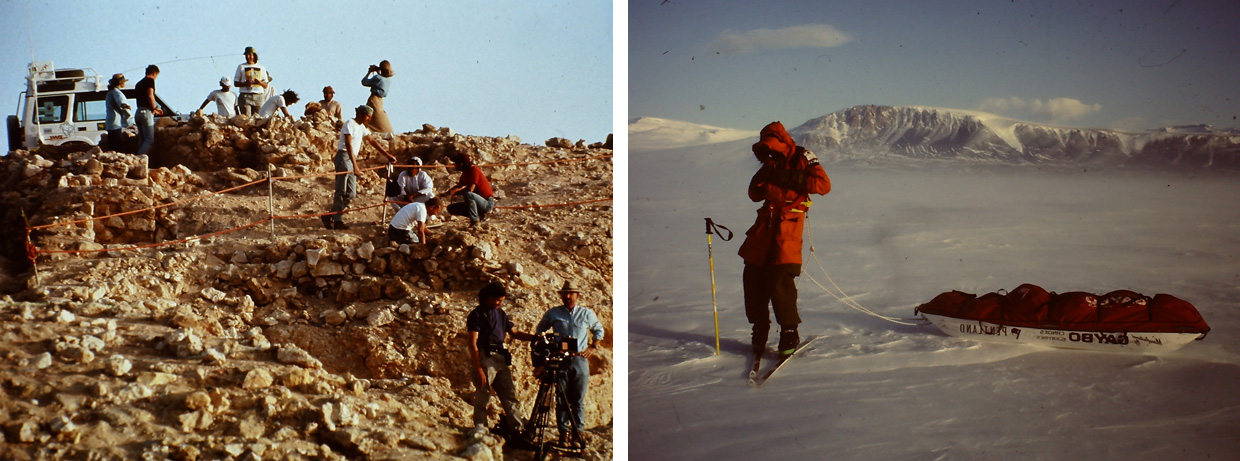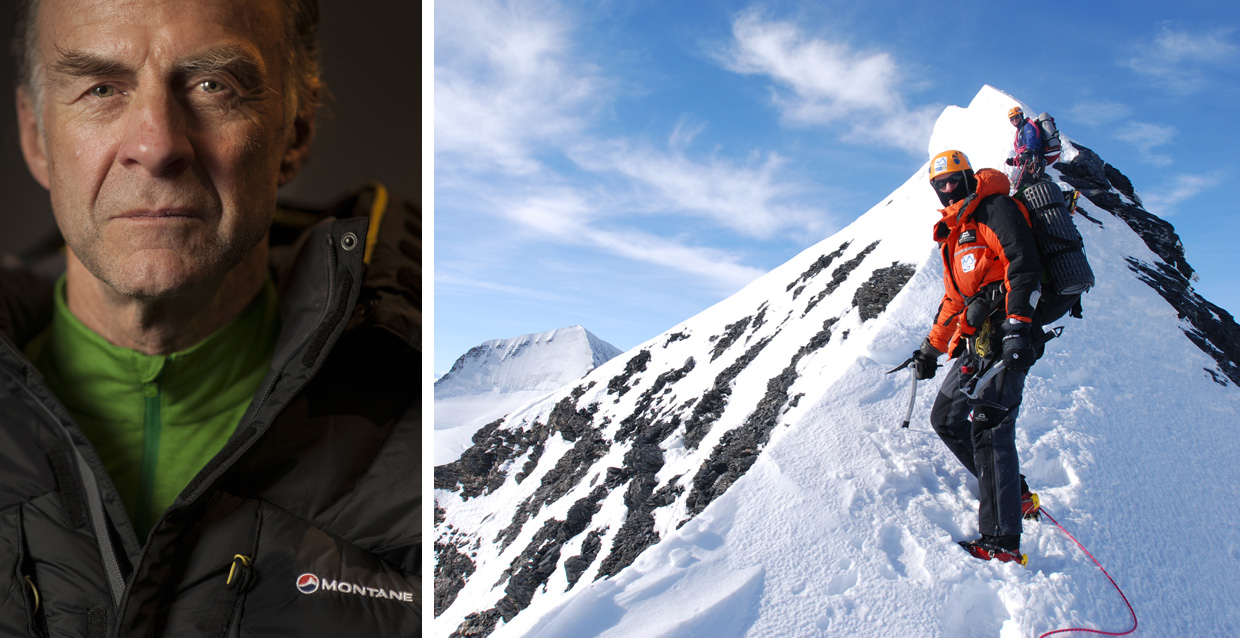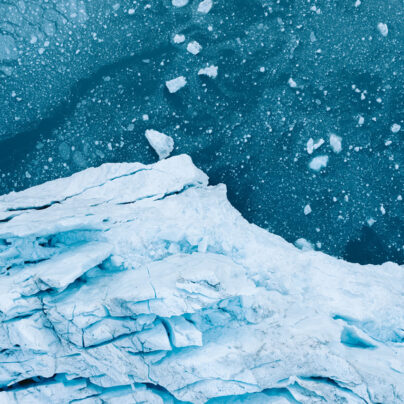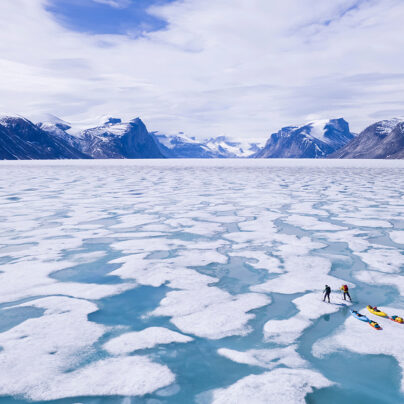Carrying On
An Interview with Sir Ranulph Fiennes
Written by Jamie Bunchuk | Portrait Photography by Martin Hartley
There were so many questions we at Sidetracked wished to pose to Sir Ranulph, but in the end we decided ask the ‘world’s greatest living explorer’ a little bit about about the technology of bygone polar days, the problems with contemporary record-breaking, where the new frontiers in exploration lie and exactly what happened to those frostbitten fingers after his impromptu tool-shed amputation.
Sir Ranulph, you’ve done a host of impressive expeditions over the course of your career – for example undertakings such as the Transglobe Expedition – which are all known about widely within the outdoor community. So to begin, I wondered if you could perhaps tell us a little bit about one expedition that enthusiastic readers may still not have heard of?
Well, we did seven expeditions in the Empty Quarter Desert. We were searching – and did not find until the last of the seven – the Lost City of Ubar, sometimes called the Atlantis of the Sands. In the Bible you have the city of Sodom. The people there were apparently naughty, God buried them and the city disappeared; that’s the myth. The Muslims have a similar version too, which is a place called Ubar, where the inhabitants behaved badly and the settlement disappeared. That’s what I started looking for in 1967 and eventually found in the early 1990s.
I didn’t do those expeditions with Charlie Burton or Mike Stroud or any of the other figures from my polar trips, I did them with my wife Ginny, who spoke Arabic and was a very good radio operator. Obviously communications were as important in the desert as they are in the snow. We kept not finding the city and each time we went to try, we had to solicit new sponsors. Land Rover were very good; they always sponsored us. But we had to keep approaching different companies with every attempt, like BP for all the fuel and local Omani supermarkets for the food. We also had to take on local Bedouin with their knowledge. It wasn’t an expedition which was widely known about, or rather the seven attempts to find it weren’t known. We eventually found Ubar in the early 1990s and it’s now the largest active excavation works in Arabia.
Your first polar-style expedition was to Greenland in the mid-1970s. Could you please tell us a bit about what the equipment and logistics were like back then, and how they might possibly compare to the kit on expeditions today?
Yes, well the communications equipment back then was all High Frequency (HF) and about two thirds of the time on an expedition you could only make contact through CW communication (morse-code). It didn’t really matter, as everybody involved got pretty quick at CW, but still one third of the time you could actually speak to people directly, which was pretty nice. The base commander and radio operator for the expeditions in those days was Ginny. She got all the gear together, trained other people and serviced and repaired the equipment. Her frequency prediction ability was brilliant. In Antarctica I can remember on one occasion, she was making voice communications with Cove Radio Station at Farnborough, whereas the British Antarctic Survey Bases were unable to contact Cambridge, which is their headquarters.
Then there’d be the person out in the field, who used HF man-packs to communicate back to the base commander. So you’d arrive at your camp at the end of the day; the person who first goes into the tent sorts it out, gets the coffee on the boil and would immediately put the radio battery up in the roof of the shelter for two hours to start warming it up. The other person – who would probably be the communicator and navigator – would be outside the tent getting slowly colder and colder, because he’d be working out what direction to set the radio equipment facing (and remember, there was no GPS until the early 1990s, because there were no satellites going over the Poles at that time). He would be using two skis sticks, definitely not metal ones, putting them in the snow about twenty yards away from each other, before stringing up antenna wire between the two sticks. The aim was for the wire to be horizontally facing the direction of where he thought Ginny was, several thousand miles away. If you’d done that correctly, then it would be the Number One important thing for establishing communications.
After that, you’d look in Ginny’s Ionospheric Prediction Book to get the best frequency by which to bounce the message off the ionosphere to the base-commander. Returning to the equipment, from the middle of the antenna wire you’d have a coaxial line coming out from it in a T-junction back through the tent door, into the tent and that would go into the radio set once you’d fixed it up. The set would then be warmed and switched on. Somebody would have a device round their knee that you whirred round and round and round and that acted as a battery charger, because in those days there were no suitable solar chargers. That would be the basic situation. You’d then hope that the HF frequency you’d chosen was correct for the behaviour of the ionosphere in the air above you. If not, you’d look on the piece of paper Ginny had given you months before, head out of the tent to change the frequency and try again. That’s a rough description, and it could take a long, long time.
In one sentence I can tell you what you now do instead of the ski stick method: you go into the tent, you take your sat phone out of your pocket, you drink your cup of tea, ring a number and tell them exactly what you want to say. Likewise with navigation, you do not spend an hour trying with a sextant tool to find the altitude of the sun or a star and then a further half an hour with sight reduction papers and a nautical almanac attempting to mathematically work out your position. You have another cup of tea, press another button on your GPS, and it tells you precisely where you’re standing. So in terms of the difference between then and now, it is simply huge.
With navigation, you do not spend an hour trying with a sextant tool to find the altitude of the sun or a star and then a further half an hour with sight reduction papers and a nautical almanac attempting to mathematically work out your position. You have another cup of tea, press a button on your GPS, and it tells you precisely where you’re standing. So in terms of the difference between then and now, it is simply huge.

The trouble with breaking world records polar-wise is that there are only two Poles. I mean a lot of people have invented great journeys, to the Magnetic Pole for instance. That’s a sort of Sunday afternoon trip but people still fail to mention it is the Magnetic Pole that they’re going to. So there is all that sort of stuff, but there remains only two Poles. This means there’s an awful lot of polar people, from Norway or wherever, turning their attention to the same areas. And either the Norwegians or our own group have broken pretty much all the polar records that stood a hundred years ago. There are not going to be any new Poles; the number of achievements cannot increase. Therefore it is a rat-race for those people to break what remains of the few world records left standing. Now, you just so happen to be born a bit late for the period of polar exploration – just as I was born too late to find the United States of America. So everyone’s got to do what they can do with what remains and that ends up – quite naturally – with what you’ve just said, which is maybe going to a Pole on a mountain bike; that sort of thing?
Yes, that whether because expeditions are still defined by trying to break a record even though there are not many records left to break –
– well it’s human nature to do that. But with us polar people, it is getting very difficult. Whereas for mountain climbers, there are terrifying 6000ft sheer, nasty faces which nobody’s yet done. So for them there doesn’t appear to be any artificiality about what they’re doing. But with the polar thing, it’s very easy for a cynic to start saying ‘well they’re just doing it for the sake of doing it and calling it a record because they want sponsorship’.
What would you consider the toughest uncompleted challenge left in the polar world?
Crossing Antarctica during the polar winter between the two equinoxes. As it has not been done by any means, whoever does it first using vehicles or whatever will still break a record and then the next people will need to do it on skis, with or without wind help. Eventually, you’ll then get the same thing with that one: people doing it solo, or female, or over-seventy, or on a pogo-stick with lots of haemorrhoid cream and so on and so forth.
You’ve raised an incredible amount for charity over the years, £16.2m at the latest count. What is your personal motivation for associating your expeditions with charity fundraising?
Well I have been accused of being selfishly selective, meaning that when I had a massive heart attack it so happened that the next one we were raising for was the British Heart Foundation. Then, when I got cancer, I seemed to be concentrating on Marie Curie Cancer Care. But it didn’t actually work that way, but I can see why it is suspicious.
But in terms of a more general linking of expeditions and charity?
Yes, well the very first time we did it was in the early 80s. I was talking with Prince Charles who’s been our patron for nearly forty years. He liked being briefed on the next expedition of which he was patron and he suddenly asked: ‘Who are we raising money for this time?’
And I said: ‘Umm. Nobody Sir. We don’t, this is an expedition. It’s not about raising money.’
And he said: ‘I thought we always had been [about fundraising], and if I’m going to carry on being patron we’re going to have to raise money for charities’.
So I asked him: ‘Who?’ And he said he’d let me know and a bit later he said Multiple Sclerosis. We got £4.2m for that one. So we then did, at his behest, start raising money for charities. However we found that we couldn’t always choose them ourselves. Sometimes the company says they will only sponsor us if it’s their charity that we raise money for.
So as well as being a commendable activity in its own right, it is also part and package of getting an expedition off the ground?
Not always. I much prefer if I can choose the charity, but obviously if a particular sponsor looks like saying yes and it’s going to be over a million pounds or whatever, and if they say look ‘We’re sponsoring you, we’ll choose the charity,’ you just have to like it or lump it. Don’t you?
Crossing Antarctica during the polar winter between the two equinoxes. As it has not been done by any means, whoever does it first using vehicles or whatever will still break a record and then the next people will need to do it on skis, with or without wind help.

What we do as a group – bearing in mind most of us have been working together on expeditions for over thirty years – is we divide projects into two categories. If it’s an expedition to break world records well that’s one thing, but if it’s to raise money for charity then we go for easier targets that have been done many times, like the Eiger or Everest or marathons of whatever. So, there’s two distinct things that we do. Now talking just about trying to break world records, we look to see why the Norwegians or the Canadians or whoever have tried and failed to break that particular record before us; why they didn’t make it. It was very often because they ran into big hardships and started suffering physically and maybe mentally. It wore them down, and if they’d only avoided that particular bit of bad nature or risk – or planned the dates differently so that they wouldn’t be out there when the ultraviolet summer sun is melting the ice – things could have gone more smoothly for them. If they’d done their planning in order to avoid risk then they might have succeeded. So we plan very definitely not to suffer or take risks.
But whilst you can negate some of the effects of suffering and hardship, they have inevitably been part and parcel of your career. You haven’t gone on such gruelling endeavours and then always had a particularly nice time of things. Have those experiences lead to any refinement in the planning and execution of such projects over the course of the years?
Yes. Wherever we’ve had a problem or lost a digit or something, on any member of the team due to – afterwards some might call it bad planning – we review what happened and why. And you have to remember that if you’re doing something that hasn’t actually been done before, for example the world record was not as far as you’ve already got, then you’re in a period of unknownness. Nobody’s done it before; the experts have tried. Are we sure that humans can actually do it? Can a man do that distance, carrying that amount of food and supplies on an unsupported expedition? You don’t really know, even if you’re with a doctor like Mike Stroud, who is a top nutritionist. Therefore you have a degree of uncertainty about everything, which means how the hell could you have planned it differently if you don’t have any basis of previous knowledge to make your plans off of? So criticism from outside is difficult to put up with.
We touched upon the idea that ‘world first’ endeavours within the polar environment are beginning to dry up. If that is the case, where do you think the next arena lies for humans to push the boundaries of exploration in? What field will the transition shift into?
If we carry on in the way you’ve just said – i.e. if you’ve done it by foot, somebody will do it by mountain bike – all that stuff you can summarise as carrying on, and it will carry on and I have nothing against it at all. But in terms of real exploration as opposed to adventuring, which are two different things, the oceans and space are the most obvious areas. You need to be pretty intelligent to get to be in the small body of people, mostly from France and America for under the sea, and America and Russia (and now possibly India and China) for going into space. But in terms of botanists and glaciologists or geologists there’s all sorts of places where they can explore, in areas where someone may have been before them. If you take a botanist into the middle of a jungle there may have been previous botanists there, but they wouldn’t have had the knowledge or instruments scientists have today. They can go into the jungle and find a flower and find a chemical or medicine inside that flower completely unknown to science. That is exploration.
This is quite a silly question to finish on but I really wanted to ask, what did you do with your fingers after you cut them off? Did you throw them away?
No, no. I couldn’t. I don’t like being superstitious, but I found that I’d been with them for so many years that I couldn’t just throw them away. So I put them in the desk drawer. Then, I don’t know, two or three years later, they disappeared and to this day I have no clue what happened to them.




